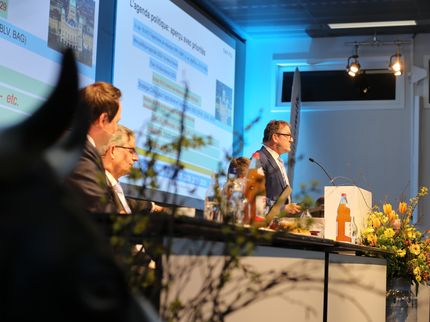How do the noodles get to the village?
Tests with delivery drones begin
Advertisement
In rural regions, it has become increasingly difficult to obtain food in recent decades due to the closure of many stores. People without their own car in particular often have to make some effort to buy fresh bread, vegetables, milk or cheese. Are delivery drones a solution for such regions? Two projects are now investigating this.

Symbol image
computer generated pciture
In Wusterhausen in Brandenburg, northwest of Berlin, there is an "urban-rural drone" project. According to the municipality, the aim is to test whether transport drones are suitable for supplying residents in remote parts of the town with groceries and everyday goods. The first delivery drones are scheduled to begin flying in Wusterhausen in spring 2024. The project is financially supported by the German Federal Ministry of Agriculture.
The second drone project will start this Thursday under the name "Drolex" in Michelstadt, Hesse, southeast of Darmstadt.
Supported by the Federal Ministry of Transport, the aim there is also to improve local supply. "Drolex" stands for "drone cargo bike express delivery." The idea is to combine goods transport by cargo bike with drone transport.
Scientist Winfried Eberhardt conducts research on living conditions and local supply in rural areas and follows the projects with great interest. Eberhardt works at the von Thünen Institute, the Federal Research Institute for Rural Areas, Forests and Fisheries in Braunschweig - and has many questions: "How high are the delivery costs? Is such a delivery network economical?" he asks in an interview with Deutsche Presse-Agentur. Technical questions such as range and possible use in unfavorable weather, for example strong winds, would also have to be clarified. "The transport box also has only a limited capacity, which is by no means equivalent to the bulk purchase of a household."
One issue, he said, may also be the public's acceptance of public drone flights: "How do people feel about drones flying through the place now?" Overall, he sees "more challenges than opportunities" so far. "Whether it will find acceptance now, I don't know. But it should definitely be tried to gain insights."
Kai Hudetz of the Cologne-based Institute for Retail Research is also skeptical about whether drones can ensure local supply in rural areas on a large scale. Such a drone delivery service would be extremely costly and "impossible to refinance in the mass market," the retail expert told Deutsche Presse-Agentur. Such services would only be accepted if they were subsidized. "If the order is delivered free of delivery costs, then it becomes interesting for convenience reasons." Hudetz also sees limitations in the delivery volume and range of the devices.
He sees a market for drone delivery as a premium service - but not at zero cost. For example, he said, a drone could deliver medications quickly and without contact. "If a drone drops my medicine on the balcony, that's a very exciting topic." He also considers the rapid delivery of spare parts, for example, for do-it-yourselfers who need a specific component during a repair to be conceivable. "There, if necessary, the effort of getting into the car yourself and driving to the hardware store is weighed in favor of convenient delivery for, say, a €12.95 delivery fee."
Trade expert Gerrit Heinemann from the Niederrhein University of Applied Sciences is also skeptical. Deliveries by drone are only possible to a very limited extent in this country, he says, because of the heavy regulation of drone flights for airspace safety reasons. He does not see widespread possibilities for use. He also does not see a future for the use of cargo bicycles because of the additional costs involved.
future: "Anything that makes food in Germany more expensive than the food that is at the discounters is, in my view, at least at the moment, not feasible, because the German buys price-oriented and doesn't see the point of paying even one cent more." Customers would not accept additional costs in the foreseeable future.
Meanwhile, the basic problem of fewer and fewer stores in the countryside is indisputable. "In many villages, the infrastructure as a whole is thinning out more and more," Eberhardt notes. "We have fewer and fewer doctors, pharmacies, restaurants, bakers, butchers. Banks are pulling out, the post office is also falling away." The supply situation is in part very unfavorable, he says.
To illustrate this, the expert cites a figure: between 1990 and 2020, for example, the number of smaller grocery stores with up to 400 square meters of sales area in Germany fell from 66,500 to around 8,400. However, alternative offers have sometimes gained a foothold in the affected places after the closure. For example, there are village and community stores or mobile services such as supermarkets on wheels. There are also an increasing number of food vending machines./tob/DP/zb (dpa)
Note: This article has been translated using a computer system without human intervention. LUMITOS offers these automatic translations to present a wider range of current news. Since this article has been translated with automatic translation, it is possible that it contains errors in vocabulary, syntax or grammar. The original article in German can be found here.






























































